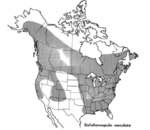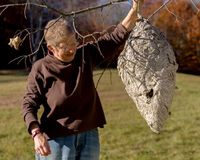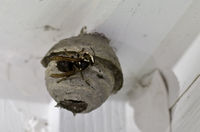Dolichovespula: Difference between revisions
No edit summary |
mNo edit summary |
||
| (12 intermediate revisions by 3 users not shown) | |||
| Line 7: | Line 7: | ||
thumb]] | thumb]] | ||
Kingdom: '' | {| class="wikitable" style="text-align:left; float:center; margin-left: 10px; | ||
|+ !colspan="2" style="min-width:12em; text-align: center; background-color: rgb(235,235,210)|'''Scientific Classification''' | |||
|- | |||
!style="min-width:6em; |Kingdom: | |||
|style="min-width:6em; |Animalia | |||
|- | |||
!style="min-width:6em; |Phylum: | |||
|style="min-width:6em; |[http://soil.geology.buffalo.edu/index.php/Insects Arthropoda] | |||
|- | |||
!style="min-width:6em; |Class: | |||
|style="min-width:6em; |Insecta | |||
|- | |||
!style="min-width:6em; |Order: | |||
|style="min-width:6em; |[[Hymenoptera]] | |||
|- | |||
!style="min-width:6em; |Family: | |||
|style="min-width:6em; |''Vespidae'' | |||
|- | |||
!style="min-width:6em; |Genus: | |||
|style="min-width:6em; |''Dolichovespula'' | |||
|} | |||
=='''Overview'''== | |||
[[File:map.png|right|150px| Fig 2. Distribution of ''Dolichovespula maculate'' across North America. [2] | [[File:map.png|right|150px| Fig 2. Distribution of ''Dolichovespula maculate'' across North America. [2] | ||
|thumb]] | |thumb]] | ||
Dolichovespla are a genus of wasps, in the family Vespidae. There are 24 recognized species of Dolichovespla: | ''Dolichovespla'' are a genus of social wasps, in the family ''Vespidae''. Its common names include the yellow jacket, bald-faced hornet, white-faced hornet, bald hornet, black jacket, and bull wasp. They can be found in most of the lower 48 states and throughout Canada and Alaska. Habitats vary between species, but they can be found mostly in forested areas or in vegetation in urban areas. Nests are generally located in trees and bushes, but can occasionally be found under rock overhangs and on the sides of buildings. There are 24 recognized species of ''Dolichovespla''[10][11][12]: | ||
{| class="wikitable" width="50%" | |||
{| class="wikitable" width=" | |||
|valign=top| | |valign=top| | ||
- Dolichovespula adulterina | - ''Dolichovespula adulterina'' | ||
- Dolichovespula albida | - ''Dolichovespula albida'' | ||
- Dolichovespula alpicola | - ''Dolichovespula alpicola'' | ||
- Dolichovespula arenaria | - ''Dolichovespula arenaria'' | ||
- Dolichovespula arctica | - ''Dolichovespula arctica'' | ||
- Dolichovespula asiatica | - ''Dolichovespula asiatica'' | ||
- Dolichovespula baileyi | - ''Dolichovespula baileyi'' | ||
- Dolichovespula carolina | - ''Dolichovespula carolina'' | ||
- Dolichovespula flora | - ''Dolichovespula flora'' | ||
- Dolichovespula kuami | - ''Dolichovespula kuami'' | ||
- Dolichovespula lama | - ''Dolichovespula lama'' | ||
- Dolichovespula loekenae | - ''Dolichovespula loekenae'' | ||
|valign=top| | |valign=top| | ||
- Dolichovespula maculata | - ''Dolichovespula maculata'' | ||
- Dolichovespula media | - ''Dolichovespula media'' | ||
- Dolichovespula norvegicoides | - ''Dolichovespula norvegicoides'' | ||
- Dolichovespula norwegica | - ''Dolichovespula norwegica'' | ||
- Dolichovespula omissa | - ''Dolichovespula omissa'' | ||
- Dolichovespula pacifica | - ''Dolichovespula pacifica'' | ||
- Dolichovespula pacifica xanthicincta | - ''Dolichovespula pacifica xanthicincta'' | ||
- Dolichovespula panda | - ''Dolichovespula panda'' | ||
- Dolichovespula saxonica | - ''Dolichovespula saxonica'' | ||
- Dolichovespula sinensis | - ''Dolichovespula sinensis'' | ||
- Dolichovespula stigma | - ''Dolichovespula stigma'' | ||
- Dolichovespula sylvestris | - ''Dolichovespula sylvestris'' | ||
|} | |} | ||
==''' Dolichovespula maculata '''== | |||
''Dolichovespula maculata'', or bald-faced hornets, get their name from the white markings on the face, legs, thorax, and abdomen. Aside from these markings, the body is dark black. They have brown wings and brown eyes. They are the largest species in the ''Dolichovespula'' genus. Workers can grow to be up to 12-14 mm long, while the queen is 18-20 mm long.[13] | |||
== Behavior and Colonization == | |||
[[File:nest.jpeg|left|200px|Fig 3. ''Dolichovespula maculate'' nest with woman for scale. [8]|thumb]] These hornets are omnivorous and will feed on a wide variety of live prey and plant materials. Live meals will be returned to the nest where they are chewed up and fed to young hornets. [3] Workers will feed on nectar, tree sap and fruit pulp, their favorite being the flesh of apples. [6] They are generally considered useful by humans due to their predation of pests such as flies, spiders, caterpillars, etc. In the spring, fertilized queens that have overwintered in sheltered areas such as in hollow trees, rock piles, under logs, and in buildings, will become active and begin to build a nest. [1] Once a nest is formed, the queen will lay an initial brood of eggs which hatch and take over the role of growing the nest and feeding future generations. Colonies will average a count of 400 individuals but can range from 100 – 700. In the fall , October and early November, newly created and fertilized queens will find a spot to overwinter and the rest of the colony will die off. | |||
==Defense Mechanisms== | |||
''Dolichovespula maculata'', or bald-faced hornets, defend their nests aggressively against all threats. Specifically, they can shoot venom from the stinger directly into the eyes of the threat. This venom causes temporary blindness or watering of the eyes. The sting itself can be painful, itchy or burning as well as causing swelling at the site of the sting. [4] While these hornets can be helpful in pest control for humans, some humans are allergic to the venom, and with nests in close proximity to human development, it can be accidental that humans are perceived as a threat. When this happens, different methods of control are applied that mainly involve treating the nest. [4] | |||
== | ==Importance In Soil== | ||
[[File:queen.jpg|right|200px| Fig 4. ''Dolichovespula maculate'' nest being made by a queen hornet. [9]|thumb]] The nest that the hornets | [[File:queen.jpg|right|200px| Fig 4. ''Dolichovespula maculate'' nest being made by a queen hornet. [9]|thumb]] The nest that the hornets build is made from cellulose from rotting and weathered wood and starch from the hornet’s saliva to form a water resistant papery substance. This action of scouring for degraded wood makes them part of the [[soil]] [[decomposition]] cycle. They also play a role in moving energy up the food chain through feeding and providing energy for other life when all of the colony, besides the fertilized queen, die off in the fall. These nests also provide a nutrition for parasites that require the nest as a food source. Female Bee Moths ([https://en.wikipedia.org/wiki/Aphomia_sociella ''Aphomia sociella'']) have been known to lay eggs in hornet nests. The hatched larvae will then proceed to feed on the eggs, larvae, and pupae left unprotected by the wasps, sometimes destroying large sections as they tunnel throughout the nest looking for food. [5] | ||
==References== | ==References== | ||
| Line 115: | Line 124: | ||
http://bioweb.uwlax.edu/bio210/s2012/bollinge_seth/nutrition.htm | http://bioweb.uwlax.edu/bio210/s2012/bollinge_seth/nutrition.htm | ||
[7] “Georgia Department of Agriculture.” Baldfaced Hornets - Ga Dept of Agriculture, agr.georgia.gov/baldfaced-hornets.aspx. | [7] “Georgia Department of [[Agriculture]].” Baldfaced Hornets - Ga Dept of Agriculture, agr.georgia.gov/baldfaced-hornets.aspx. | ||
http://agr.georgia.gov/baldfaced-hornets.aspx | http://agr.georgia.gov/baldfaced-hornets.aspx | ||
| Line 129: | Line 138: | ||
[12] Kimsey, L., and J. Carpenter. 2012. The Vespinae of North America (Vespidae, Hymenoptera). Journal of Hymenoptera Research 28:37–65. | [12] Kimsey, L., and J. Carpenter. 2012. The Vespinae of North America (Vespidae, Hymenoptera). Journal of Hymenoptera Research 28:37–65. | ||
[13] Hauze, D. (n.d.). Dolichovespula maculata. https://animaldiversity.org/accounts/Dolichovespula_maculata/. | |||
Latest revision as of 16:55, 30 March 2025
Classification

| Kingdom: | Animalia |
|---|---|
| Phylum: | Arthropoda |
| Class: | Insecta |
| Order: | Hymenoptera |
| Family: | Vespidae |
| Genus: | Dolichovespula |
Overview

Dolichovespla are a genus of social wasps, in the family Vespidae. Its common names include the yellow jacket, bald-faced hornet, white-faced hornet, bald hornet, black jacket, and bull wasp. They can be found in most of the lower 48 states and throughout Canada and Alaska. Habitats vary between species, but they can be found mostly in forested areas or in vegetation in urban areas. Nests are generally located in trees and bushes, but can occasionally be found under rock overhangs and on the sides of buildings. There are 24 recognized species of Dolichovespla[10][11][12]:
|
- Dolichovespula adulterina - Dolichovespula albida - Dolichovespula alpicola - Dolichovespula arenaria - Dolichovespula arctica - Dolichovespula asiatica - Dolichovespula baileyi - Dolichovespula carolina - Dolichovespula flora - Dolichovespula kuami - Dolichovespula lama - Dolichovespula loekenae |
- Dolichovespula maculata - Dolichovespula media - Dolichovespula norvegicoides - Dolichovespula norwegica - Dolichovespula omissa - Dolichovespula pacifica - Dolichovespula pacifica xanthicincta - Dolichovespula panda - Dolichovespula saxonica - Dolichovespula sinensis - Dolichovespula stigma - Dolichovespula sylvestris |
Dolichovespula maculata
Dolichovespula maculata, or bald-faced hornets, get their name from the white markings on the face, legs, thorax, and abdomen. Aside from these markings, the body is dark black. They have brown wings and brown eyes. They are the largest species in the Dolichovespula genus. Workers can grow to be up to 12-14 mm long, while the queen is 18-20 mm long.[13]
Behavior and Colonization

These hornets are omnivorous and will feed on a wide variety of live prey and plant materials. Live meals will be returned to the nest where they are chewed up and fed to young hornets. [3] Workers will feed on nectar, tree sap and fruit pulp, their favorite being the flesh of apples. [6] They are generally considered useful by humans due to their predation of pests such as flies, spiders, caterpillars, etc. In the spring, fertilized queens that have overwintered in sheltered areas such as in hollow trees, rock piles, under logs, and in buildings, will become active and begin to build a nest. [1] Once a nest is formed, the queen will lay an initial brood of eggs which hatch and take over the role of growing the nest and feeding future generations. Colonies will average a count of 400 individuals but can range from 100 – 700. In the fall , October and early November, newly created and fertilized queens will find a spot to overwinter and the rest of the colony will die off.
Defense Mechanisms
Dolichovespula maculata, or bald-faced hornets, defend their nests aggressively against all threats. Specifically, they can shoot venom from the stinger directly into the eyes of the threat. This venom causes temporary blindness or watering of the eyes. The sting itself can be painful, itchy or burning as well as causing swelling at the site of the sting. [4] While these hornets can be helpful in pest control for humans, some humans are allergic to the venom, and with nests in close proximity to human development, it can be accidental that humans are perceived as a threat. When this happens, different methods of control are applied that mainly involve treating the nest. [4]
Importance In Soil

The nest that the hornets build is made from cellulose from rotting and weathered wood and starch from the hornet’s saliva to form a water resistant papery substance. This action of scouring for degraded wood makes them part of the soil decomposition cycle. They also play a role in moving energy up the food chain through feeding and providing energy for other life when all of the colony, besides the fertilized queen, die off in the fall. These nests also provide a nutrition for parasites that require the nest as a food source. Female Bee Moths (Aphomia sociella) have been known to lay eggs in hornet nests. The hatched larvae will then proceed to feed on the eggs, larvae, and pupae left unprotected by the wasps, sometimes destroying large sections as they tunnel throughout the nest looking for food. [5]
References
[1] Jacobs, Steve. “Baldfaced Hornet (Department of Entomology).” Department of Entomology (Penn State University), 2015, ento.psu.edu/extension/factsheets/baldfaced-hornet. https://ento.psu.edu/extension/factsheets/baldfaced-hornet
[2] “Dolichovespula Maculata, Distribution.” Dolichovespula Maculata, Distribution Image, www.discoverlife.org/mp/20p?see=I_SD4398&res=640. https://www.discoverlife.org/mp/20p?see=I_SD4398&res=640
[3] Heinrich, B. J. J. o. C. P. B. 1984. Strategies of thermoregulation and foraging in two vespid wasps, Dolichovespula maculata andVespula vulgaris. 154:175-180. https://link.springer.com/article/10.1007/BF00684142
[4] Oswalt, Donald A, and Patricia A Zungoli. “Baldfaced Hornets.” Home & Garden Information Center | Clemson University, South Carolina, hgic.clemson.edu/factsheet/baldfaced-hornets/. https://hgic.clemson.edu/factsheet/baldfaced-hornets/
[5] Gambino, P. J. J. o. t. N. Y. E. S. 1995. Dolichovespula (Hymenoptera: Vespidae), hosts of Aphomia sociella (L.)(Lepidoptera: Pyralidae).165-169. https://www.jstor.org/stable/25010152?seq=1#page_scan_tab_contents
[6] “Dolichovespula Maculata.” Bio 210 Vespula Maculata, bioweb.uwlax.edu/bio210/s2012/bollinge_seth/nutrition.htm. http://bioweb.uwlax.edu/bio210/s2012/bollinge_seth/nutrition.htm
[7] “Georgia Department of Agriculture.” Baldfaced Hornets - Ga Dept of Agriculture, agr.georgia.gov/baldfaced-hornets.aspx. http://agr.georgia.gov/baldfaced-hornets.aspx
[8] Holland, Mary. “Bald-Faced Hornet Nests No Longer Inhabited (If You Live Where There Has Been a Hard Frost).” Naturally Curious with Mary Holland, 3 Nov. 2015, naturallycuriouswithmaryholland.wordpress.com/2015/11/03/bald-faced-hornet-nests-no-longer-inhabited-if-you-live-where-there-has-been-a-hard-frost/. https://naturallycuriouswithmaryholland.wordpress.com/2015/11/03/bald-faced-hornet-nests-no-longer-inhabited-if-you-live-where-there-has-been-a-hard-frost/
[9] “Bald-Faced Hornet, Queen - Dolichovespula Maculata - a Photo on Flickriver.” Flickriver, www.flickriver.com/photos/maximillian_millipede/3558361392/. https://www.flickriver.com/photos/maximillian_millipede/3558361392/
[10] ADW: Dolichovespula: CLASSIFICATION. (n.d.). . https://animaldiversity.org/accounts/Dolichovespula/classification/.
[11] Dolichovespula. (n.d.). . http://www.nic.funet.fi/pub/sci/bio/life/insecta/hymenoptera/apocrita/vespidae/dolichovespula/index.html.
[12] Kimsey, L., and J. Carpenter. 2012. The Vespinae of North America (Vespidae, Hymenoptera). Journal of Hymenoptera Research 28:37–65.
[13] Hauze, D. (n.d.). Dolichovespula maculata. https://animaldiversity.org/accounts/Dolichovespula_maculata/.